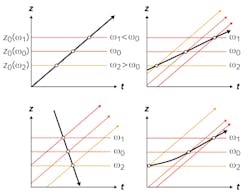Physicists at Université Paris-Saclay (Gif-sur-Yvette, France) have theoretically determined that ultrafast laser pulses can, when focused, be made to travel at different velocities when propagating in a vacuum. In fact, Albert Einstein's theory of special relativity is not being violated in their simulations because it is not the velocity of the pulse as a whole that is being altered-instead, it is the velocity of the pulse intensity peak. The researchers take advantage of the interaction between two effects. The first, which is commonly produced by refractive optics, results in pulse-front curvature (PFC) in the near-field and longitudinal chromatism (LC) in the far-field. The result is chirped pulses with longitudinal chromatism (CPLC). The second is conventional temporal frequency chirp. The combination of these two effects can provide precise control of the movement of the pulse intensity peak over time.
As a result of PFC and LC, different frequencies ω in a light pulse end up being focused at different positions along the optical axis (in the example, ω1 < ω0 < ω2), which are shown as different-colored lines in the figure. When a beam propagating in vacuum has no frequency chirp, the pulse intensity peak moves at the standard light velocity c (top left). However, when a frequency chirp is applied such that the frequencies that have their focus at larger distances from the light source along the optical axis are retarded in time, the velocity of the pulse intensity peak is less than c (top right). In fact, the pulse peak velocity can be made to be less than zero (bottom left; moving back towards the source in time) or to have a nonuniform velocity (bottom right; showing an acceleration) as it propagates. The researchers say that the control that this technique gives to the potential experimenter could lead to new applications in laser-matter interactions such as laser-driven particle acceleration. Reference: A. Sainte-Marie et al., Optica (2017); https://doi.org/10.1364/OPTICA.4.001298.

